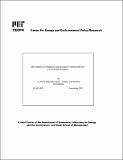| dc.description.abstract | November 1997This paper reports on the second year of compliance with the sulfur dioxide (SO2) emissions-reduction and -trading provisions of the Title IV of the 1990 Clean Air Act Amendments (CAAA). The material is intended as a supplement to Ellerman, et al. (1997), which evaluated the emissions-trading program in 1995, and to which the reader is referred for background and definitions of terms. In the main, compliance with Title IV in 1996 was very similar to that which occurred in 1995. Sulfur dioxide emissions from affected units were about 4.0 million tons lower than they would have been in the absence of the emissions restrictions specified in Title IV. As in 1995, about half of the emissions reduction could be attributed to the use of scrubbers and the other half to switching. Finally, at 5.43 million tons, 1996 emissions from these units were significantly below the 1996 "cap" of 8.12 million tons, not to mention the 3.25 million allowances banked from 1995 that could have been used in 1996. However, the more interesting aspect of compliance with Title IV in 1996 lies not so much in the aggregate results as in the small changes on the margin that indicate how affected parties were using the flexibility afforded by emissions trading. In this regard, the most significant change was a 6% increase in emission from affected units. With the decreasing number of allowances issued annually as Phase II approaches and a fixed Phase II "cap," one would have expected emissions to be lower in 1996 than in 1995, not higher. The unexpected increase in average emissions rates is, however, the mirror image of the equally unexpected fall in the price of allowances between 1994 and 1995. With lower allowance prices, it is cheaper in at least some locations to spend more on allowances in order to take advantage of lower-priced, higher-sulfur coal. | en_US |
